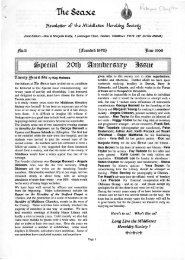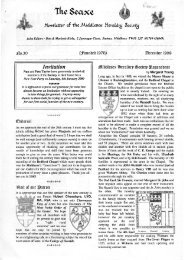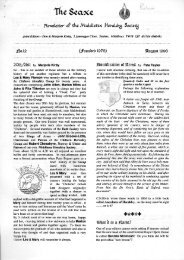No.57 - Middlesex Heraldry Society
No.57 - Middlesex Heraldry Society
No.57 - Middlesex Heraldry Society
You also want an ePaper? Increase the reach of your titles
YUMPU automatically turns print PDFs into web optimized ePapers that Google loves.
Sargeant of Arms escaped. Colonel Thomas Atkins and Rowland Wilson had been appointed<br />
by Cromwell to serve on the Court but like Philip Skippon had refused to have anything to do<br />
with it.<br />
To be continued .<br />
Two Portuguese Armorials<br />
++++++++++++++++<br />
1755 is not a year that readily comes to<br />
mind when one thinks of notable dates.<br />
In fact in the time line in „The Times<br />
Complete History of the World‟ the only<br />
event listed for that year is that under<br />
Asia, “Alaungpaya founds Rangoon and<br />
reunites Burma (to 1824)”. It is<br />
remarkable that an event that occurred<br />
that year in Europe on All Saints Day<br />
and out of which saw the birth of the<br />
science of Seismology is not considered<br />
to be significant enough to be<br />
mentioned.<br />
It was approximately just before 9.45am<br />
on the 1st November 1755 that an<br />
earthquake measuring 8.5 to 9 on the<br />
Richter scale occurred in the Atlantic<br />
Ocean some 125-175 miles south of<br />
Lisbon. This can be compared with the<br />
earthquake that hit Haiti in January this<br />
year which measured 7.0 on the Richter<br />
scale. The main tremor was followed<br />
minutes later by two major aftershocks<br />
and were felt right across Portugal,<br />
Spain and Morocco. An hour later three<br />
successive tsunami waves roared up the<br />
Tagus estuary completely devastating<br />
the city and sweeping everything caught<br />
The Royal Arms of Portugal from The Book of Nobility. in its path along with it. The effects of<br />
the tsunamis were felt as far apart as<br />
Ireland and the West Indies. But it was Lisbon, the nearest major city to the earthquakes‟<br />
epicentre that bore the brunt of the devastation. Being All Saints Day, candles had been lit in<br />
the churches and the cathedral. As a consequence the earthquake and resulting tsunamis was<br />
followed by fire which raged out of control for over a week destroying anything that had survived<br />
the earthquake itself. The number of people who lost their lives is still uncertain. In the early<br />
20th century a meticulous study was carried out by Francisco Luiz Pereira de Sousa who<br />
estimated the death toll in Lisbon to be in the order of 30,000 to 40,000. In the rest of Portugal,<br />
Spain and Morocco the death toll was put at a further 10,000.<br />
It was the lower part of the city that suffered the most. The River Palace, the Customs House,<br />
and the High Court were reduced to rubble as was the palace of the Inquisition. The cathedral<br />
was gutted by fire, the opera house collapsed and many nobles‟ houses were completely<br />
destroyed. The cultural losses are incalculable. The magnificent collection of over 200 paintings<br />
including works by Titian, Correggio, and Rubens which were held in the Annunciada Palace,














